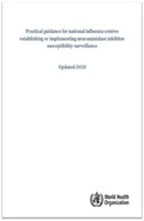Laboratory methodologies for testing the antiviral susceptibility of influenza viruses
The need for surveillance of antiviral susceptibility of influenza viruses has grown in recent years. The laboratory methodologies described below have been developed and reviewed by an Expert Working Group on Antiviral Susceptibility for the WHO Global Influenza Surveillance and Response System (GISRS). They are intended for National Influenza Centres in GISRS and other laboratories that test for influenza antiviral susceptibility.
M2 ion channel inhibitor
Approaches to M2 inhibitor resistance testing
M2 inhibitor resistance is associated with amino acid substitutions, due to single-nucleotide polymorphism (SNP) between residues 26-34 in the transmembrane domain of the M2 protein. The most commonly detected M2 amino acid substitution that confers M2 inhibitor resistance is S31N.
The frequency of M2 inhibitor resistance in currently circulating seasonal influenza A viruses is very high (>99%) . The M2 inhibitors are also ineffective against influenza B viruses. Consequently, WHO does not recommend the use of the M2 inhibitors for the treatment of patients infected with circulating seasonal influenza viruses.
M2 inhibitor resistance testing is thus not considered a priority activity for National Influenza Centres in GISRS.
Neuraminidase inhibitor (NAI)
Polymerase acidic (PA) protein inhibitor
Monitoring antiviral resistance in influenza viruses with pandemic potential using Tool for Influenza Pandemic Risk Assessment (TIPRA)
Global updates on the susceptibility of human or animal influenza viruses to antivirals
Summary reports on influenza antiviral susceptibility meetings published in the WHO Weekly Epidemiological Record
Publication

Practical guidance for national influenza centres establishing or implementing neuraminidase inhibitor...
This document discusses the practical considerations that must be assessed when deciding whether implementation of AVST within a laboratory is practical,...

WHO has developed this manual in order to strengthen the laboratory diagnosis and virological surveillance of influenza infection by providing standard...
